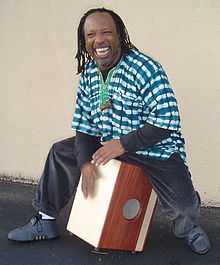Cajón

A cajón (Spanish pronunciation: [kaˈxon] (Ka-hone), "crate", "drawer", or "box with a hole in it") is a six sided, box-shaped percussion instrument originally from Perú, played by slapping the front or rear faces (generally thin plywood) with the hands, fingers, or sometimes various implements such as brushes, mallets, or sticks.
Description

Sheets of 0.5 to 0.75 inches (1.3 to 1.9 cm) thick wood are generally used for five sides of the box. A thinner sheet of plywood is nailed on as the sixth side, and acts as the striking surface or head. A sound hole is cut on the back side opposite the head or tapa.
The top edges are often left unattached and can be slapped against the box. The player sits astride the box, tilting it at an angle while striking the head between his knees. The modern cajón may have rubber feet, and has several screws at the top for adjusting percussive timbre. Originally they would be only wooden boxes but now some versions may also have several stretched cords pressed against the tapa for a buzz like effect or tone. Guitar strings, rattles or drum snares may serve this purpose. They may also have bells on the inside near the cords. The percussionist can play the sides with the top of his palms and fingers for additional sounds.
There are also tube cajónes, which are played like a conga.

Origins and evolution
The cajón is the most widely used Afro-Peruvian musical instrument since the late 18th century.[1] Slaves of west and central African origin in the Americas, specifically Perú, are considered to be the source of the cajón drum; though the instrument is common in musical performance throughout some of the Americas and Spain.
The cajón was developed in coastal Perú during the periods of slavery in Perú, where it is associated with several Afro-Peruvian genres. The instrument reached a peak in popularity by 1850, and by the end of the 19th century cajón players were experimenting with the design of the instrument by bending some of the planks in the cajón's body to alter the instrument's patterns of sound vibration.[1]
The cajón was created by the African slaves brought to work on the coast of Perú. The slaves were forbidden to play music and therefor developed instruments that could be easily disguised as ordinary objects or tools. Originally the cajón was made of shipping crates of fruit and other articles from the Caribbean. After slavery the cajón was spread to a much larger audience including Criollos.
Given that the cajón comes from slave musicians in the Spanish colonial Americas, there are two complementary origin theories for the instrument. It is possible that the drum is a direct descendant of a number of boxlike musical instruments from west and central Africa, especially Angola, and the Antilles. These instruments were adapted by Peruvian slaves from the Spanish shipping crates at their disposal.[2] In port cities like Matanzas, Cuba they used codfish shipping crates. Elsewhere, small dresser drawers became instruments.
Another theory posits that slaves simply used boxes as musical instruments to subvert Spanish colonial bans on music in predominantly African areas;[3] In this way, cajónes could easily be disguised as seats or stools, thus avoiding identification as musical instruments. In all likelihood it is a combination of these factors - African origins and Spanish suppression of slave music - that led to the cajón's creation.
Contemporary music
Today, the cajón is heard extensively in Cuban and Coastal Peruvian musical styles such as: Tondero, Zamacueca and Peruvian Waltz, modern Flamenco and certain styles of modern Rumba.
The modern cajón is often used to accompany the acoustic guitar, and is showing up on worldwide stages in contemporary music. In fact the cajón is becoming rapidly popular in styles such as blues, pop, rock, funk, world music, fusion, jazz, etc. It is also often referred to as a "drum kit in a box" or "cajón box".
In 2001 the cajón was declared "National Patrimony" by the Peruvian National Institute of Culture.[citation needed]
The cajón has become a popular instrument in the Folk music of Ireland and is often played alongside the bodhrán.
Cajón playing styles

Besides its standard use, the cajón has been played in a variety of ways, according to different influences over time. Since it has been widely spread across the world, not only full-time percussionists, but also other musicians have begun to play the cajón. The instrument has been played not only with hands, but also with plastic and metal brushes, as normally used for drums.
Another way of playing the cajón is to use an ordinary bass drum pedal, thus turning the cajón into an indirect percussion instrument. This enables the player to beat it just like a pedal-bass-drum, but it also restricts the player's standard position.
Although much has changed, many of the original styles of Peruvian Cajón playing are played commonly along the coast. These Types Include the Landó, the Festejo, and the Zamacueca(Marinera).
Gallery
|
See also
- Music of Peru
- Flamenco
- Cajón de rumba - Cuba
- Cajón de tapeo - México
References
- ↑ 1.0 1.1 Tompkins, William David: "Afro-Peruvian Traditions" in "Music of the African Diaspora in the Americas," p. 493. Springer US Press, 2005
- ↑ Feldman, Heidi: "Black Rhythms of Peru" p. 21-22. Wesleyan University Press, 2006
- ↑ Feldman, Heidi: "Black Rhythms of Peru" p. 22. Wesleyan University Press, 2006
External links
| Wikimedia Commons has media related to Cajon. |
- How to Build a Cajón
- Cajon info site.
- Help deciding which cajon to buy.
- Videos of a cajón being played
- Cajon Lesson Website.
- Afro-Cuban cajón in religious ceremonies
- Instruments of the World - Cajon
- Brief history of the instrument with photo.
- Super Cajon
- Lewi® Cajón - Professional grade Cajón
- Kopf Cajon
| |||||||||||||||||||||||




